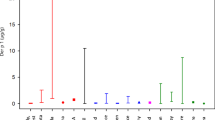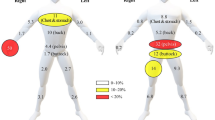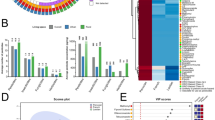Abstract
We conducted a randomized case–control trial to analyze uptake of the insecticide/arcaricide permethrin in wearers of permethrin-impregnated and non-impregnated pants in German forestry. Eighty-two male workers were each equipped for a 16-week period with permethrin-treated (test group) or with non-treated work pants (control group). Pants with or without lining to protect against cuts, obtained from two different distributors, were worn in each group. Urinary permethrin metabolite levels were measured by GC-MS/MS before, during and after wearing of the pants. Permethrin uptake was calculated using additional questionnaire data. In the control group, metabolite levels in the range of environmental background exposure (median: ~0.5 μg/l) were measured. Subjects wearing impregnated pants showed consistently significantly higher exposure levels even before the first use of the pants with a maximum after 1 week of wearing the pants (median: ~12.5 μg/l). Significant differences in internal exposure were found depending on which of the distributors the pants came from. Metabolite levels decreased probably due to permethrin losses associated with laundering the pants. Calculated permethrin uptake is below the value corresponding to the WHO-proposed acceptable daily intake. Based on our data, a marginally increased cancer risk compared with the general population cannot be excluded when wearing impregnated pants over a working-lifetime period.
This is a preview of subscription content, access via your institution
Access options
Subscribe to this journal
Receive 6 print issues and online access
$259.00 per year
only $43.17 per issue
Buy this article
- Purchase on Springer Link
- Instant access to full article PDF
Prices may be subject to local taxes which are calculated during checkout




Similar content being viewed by others
References
Oehme R, Hartelt K, Backe H, Brockmann S, Kimmig P . Foci of tick-borne diseases in southwest Germany. Int J Med Microbiol 2002; 291 (Suppl 33): 22–29.
Rath P M, Ibershoff B, Mohnhaupt A, Albig J, Eljaschewitsch B, Jürgens D et al. Seroprevalence of Lyme borreliosis in forestry workers from Brandenburg, Germany. Eur J Clin Microbiol 1996; 15: 372–377.
Hayes E B, Piesman J . How can we prevent Lyme disease? N Engl J Med 2003; 348: 2424–2430.
Cisak E, Chmielewska-Badora J, Zwoliński J, Wójcik-Fatla A, Polak J, Dutkiewicz J . Risk of tick-borne bacterial diseases among workers of Roztocze National Park (south-eastern Poland). Ann Agric Environ Med 2005; 12: 127–132.
Bhate C, Schwartz R A . Lyme disease. Part II. Management and prevention. J Am Acad Dermatol 2011; 64: 639–653.
Vaughn M F, Funkhouser SW, Lin FC, Fine J, Juliano JJ, Apperson CS et al. Long-lasting permethrin impregnated uniforms. A randomized-controlled trial for tick bite prevention. Am J Prev Med 2014; 46: 473–480.
Miller NJ, Rainone EE, Dyer MC, Gonzalez ML, Mather TN . Tick bite protection with permethrin-treated summer-weight clothing. J Med Entomol 2011; 48: 327–333.
Rozendaal J A . World Health Organization Vector Control Methods for Use by Individuals and Communities. World Health Organization:: Geneva. 1997.
Faulde MK, Uedelhoven WM, Robbins RG . Contact toxicity and residual activity of different permethrin-based fabric impregnation methods for Aedes aegypti (Diptera. Culicidae), Ixodes ricinus (Acari: Ixodidae), and Lepisma saccharina (Thysanura: Lepismatidae). J Med Entomol 2003; 40: 935–941.
Faulde MK, Uedelhoven WM, Malerius M, Robbins RG . Factory-based permethrin impregnation of uniforms. residual activity against Aedes aegypti and Ixodes ricinus in battle dress uniforms worn under field conditions, and cross-contamination during the laundering and storage process. Mil Med 2006; 171: 472–477.
Faulde M, Uedelhoven W . A new clothing impregnation method for personal protection against ticks and biting insects. Int J Med Microbiol 2006; 296 (Suppl 40): 225–229.
Kissel JC . The mismeasure of dermal absorption. J Expo Sci Environ Epidemiol 2011; 21: 302–309.
WHO. Joint meeting of the FAO Panel of Experts on Pesticide Residues in Food and the Environment and the WHO Core Assessment Group. Permethrin 1999.
WHO Major hazard control A practical Manual; An ILO Contribution to the International Programme on Chemical Safety of UNEP. International Labour Office: : Geneva. 1990.
ATSDR Toxicological Profile for Pyrethrins and Pyrethroids. Agency for Toxic Substances and Disease Registry: : Atlanta. 2003.
Appel K E, Gundert-Remy U, Fischer H, Faulde M, Mross KG, Letzel S et al. Risk assessment of Bundeswehr (German Federal Armed Forces) permethrin-impregnated battle dress uniforms (BDU). Int J Hyg Envir Heal 2008; 211: 88–104.
Tomalik-Scharte D, Lazar A, Meins J, Bastian B, Ihrig M, Wachall B et al. Dermal absorption of permethrin following topical administration. Eur J Clin Pharmacol 2005; 61: 399–404.
Rossbach B, Niemietz A, Kegel P, Letzel S . Uptake and elimination of permethrin related to the use of permethrin treated clothing for forestry workers. Toxicol Lett 2014; 231: 147–153.
Eadsforth CV, Bragt PC, van Sittert NJ . Human dose-excretion studies with pyrethroid insecticides cypermethrin and alphacypermethrin. Relevance for biological monitoring. Xenobiotica 1988 The fate of foreign compounds in biological systems 18: 603–614.
Woollen BH, Marsh JR, Laird WJ, Lesser JE . The metabolism of cypermethrin in man. differences in urinary metabolite profiles following oral and dermal administration. Xenobiotica 1992 The fate of foreign compounds in biological systems 22: 983–991.
WHO Safety of Pyrethroids for Public Health Use. WHO: : Geneva. 2005, 1–69.
U.S. Environmental Protection Agency. Permethrin Facts (Reregistration Eligibility Decision (RED) Fact Sheet). Revised May 2009.
IARC Permethrin, IARC monographs on the evaluation of carcinogenic risks to humans / World Health Organization, International Agency for Research on Cancer 1991; 53: 329–349.
Wolansky M J, Harrill J A . Neurobehavioral toxicology of pyrethroid insecticides in adult animals. Acritical review. Neurotoxicol Teratol 2008; 30: 55–78.
Koureas M, Tsakalof A, Tsatsakis A, Hadjichristodoulou C . Systematic review of biomonitoring studies to determine the association between exposure to organophosphorus and pyrethroid insecticides and human health outcomes. Toxicolo Lett 2012; 210: 155–168.
Shafer TJ, Meyer DA, Crofton KM . Developmental neurotoxicity of pyrethroid insecticides. Critical review and future research needs. Environ Health Perspect 2005; 113: 123–136.
Kegel P, Letzel S, Rossbach B . Biomonitoring in wearers of permethrin impregnated battle dress uniforms in Afghanistan and Germany. Occup Environ Med 2014; 71: 112–117.
Rossbach B, Appel KE, Mross KG, Letzel S . Uptake of permethrin from impregnated clothing. Toxicol Lett 2009, 50–55.
Schettgen T, Koch HM, Drexler H, Angerer J . New gas chromatographic-mass spectrometric method for the determination of urinary pyrethroid metabolites in environmental medicine. J Chromatogr 2002; 778: 121–130.
Goen T, Schaller KH, Drexler H . External quality assessment of human biomonitoring in the range of environmental exposure levels. Int J Hyg Environ Heal 2012; 215: 229–232.
WHO Biological Monitoring of Chemical Exposure in the Workplace. Guidelines Volume 1: : Geneva. 1996.
Poulsen OM, Holst E, Christensen. JM . A supplement to the approved IFCC Recommendation an the theory of reference values. Pure & Appl Chem 1997; 69: 1601–1611.
Umweltbundesamt. Innere Belastung der Allgemeinbevölkerung in Deutschland mit Pyrethroiden und Referenzwerte für Pyrethroid-Metabolite im Urin. Stellungnahme der Kommission “Human-Biomonitoring” des Umweltbundesamtes. Bundesgesundheitsbl Gesundheitsforsch Gesundheitsschutz 2005; 48: 1187–1193.
Schettgen T, Heudorf U, Drexler H, Angerer J . Pyrethroid exposure of the general population-is this due to diet. Toxicol Lett 2002; 134: 141–145.
Weschler C J, Nazaroff W W . SVOC exposure indoors. fresh look at dermal pathways. Indoor Air 2012; 22: 356–377.
Hughes M F, Edwards B C . In vitro dermal absorption of pyrethroid pesticides in human and rat skin. Toxicol Appl Pharmacol 2010; 246: 29–37.
Lu D, Wang D, Feng C, Jin Y, Zhou Z, Wu C et al. Urinary concentrations of metabolites of pyrethroid insecticides in textile workers, Eastern China. Environ Int 2013; 60: 137–144.
Leng, G. in Toxikologisch-arbeitsmedizinische Begründungen von BAT-Werten, edited by D. F. G. Senatskommission zur Prüfung gesundheitsschädlicher Arbeitsstoffe 2009 pp 1–19.
IARC. IARC monographs on the evaluation of carcinogenic risks to humans. Solar and ultraviolet radiation, IARC monographs on the evaluation of carcinogenic risks to humans/World Health Organization, International Agency for Research on Cancer 55 1992, 1–316.
U.S. Environmental Protection Agency. Cancer Assessment Review Committee (CARC). Permethrin. Report of the Cancer Assessment Review Committee 2002 TXR #0051220 1–18.
AGS. TRGS 910 (Technical Rules for Hazardous Substances) 2014.
Rossbach B, Kegel P, Zier U, Niemietz A, Letzel S . Protective efficacy of permethrin-treated trousers against tick infestation in forestry workers. Ann Agric Environ Med 2014; 21: 712–717.
Bjørling-Poulsen M, Andersen HR, Grandjean P . Potential developmental neurotoxicity of pesticides used in Europe. Environ Health 2008 A global access science source 7: 50.
Acknowledgements
The study was supported by the Deutsche Gesetzliche Unfallversicherung (DGUV, Projekt-Nr. FF-FP0305). We thank all participants of the study for their cooperation and all colleagues involved in local forest administrations, accident insurers and Kuratorium für Waldarbeit und Forsttechnik e.V. (KWF) for their logistical support and expert advice. Furthermore, we wish to express our gratitude to the lab team of the Institute of Occupational, Social and Environmental Medicine for their dedicated analytical work.
Author information
Authors and Affiliations
Corresponding author
Ethics declarations
Competing interests
The authors declare no conflict of interest.
Rights and permissions
About this article
Cite this article
Rossbach, B., Kegel, P., Süß, H. et al. Biomonitoring and evaluation of permethrin uptake in forestry workers using permethrin-treated tick-proof pants. J Expo Sci Environ Epidemiol 26, 95–103 (2016). https://doi.org/10.1038/jes.2015.34
Received:
Revised:
Accepted:
Published:
Issue Date:
DOI: https://doi.org/10.1038/jes.2015.34



